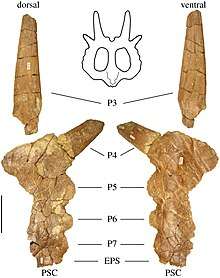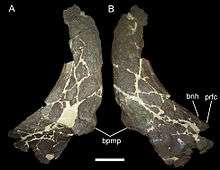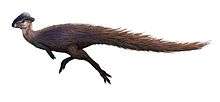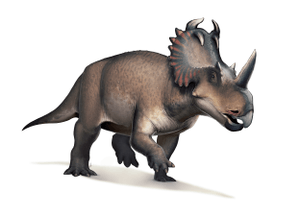Stellasaurus
Stellasaurus (meaning "star lizard"; both in reference to the shape of its head ornamentation and as an homage to the song "Starman" by David Bowie) is a genus of centrosaurine ceratopsid dinosaur that lived in Montana during the Late Cretaceous. The type and only species is Stellasaurus ancellae. Its remains have been found in the Late Campanian age Two Medicine Formation, the same geological unit which its relatives Rubeosaurus, Einiosaurus, and Achelousaurus were discovered in.[1]
| Stellasaurus | |
|---|---|
 | |
| Parietal bar of the holotype specimen MOR 492 | |
| Scientific classification | |
| Kingdom: | Animalia |
| Phylum: | Chordata |
| Clade: | Dinosauria |
| Order: | †Ornithischia |
| Family: | †Ceratopsidae |
| Subfamily: | †Centrosaurinae |
| Genus: | †Stellasaurus Wilson et al., 2020 |
| Type species | |
| †Stellasaurus ancellae Wilson et al., 2020 | |
Originally proposed as a distinct taxon in 1992, the specimens were later assigned to Rubeosaurus. In 2020 a re-evaluation questioned the referral and named it as a distinct species in a new genus. The describers saw it as a transitional form between Styracosaurus albertensis and Einiosaurus on a single evolutionary line that led to Achelousaurus and Pachyrhinosaurus.[1]
Description

Like other ceratopsid dinosaurs, Stellasaurus would have had complex cranial ornamentation. In particular, it shared similar anatomy to other derived eucentrosaurs, and has been described as having an anatomy intermediate between that of Styracosaurus albertensis and Einiosaurus, its presumed ancestor and descendant. Like the former, it possessed a very long nasal horn, larger than that found in Centrosaurus. This horn is erect and recurved (pointed inwards, unlike the very procurved horn of Einiosaurus which points in the opposite direction) and compressed, laterally. The supraorbital condition was also very similar to Styracosaurus albertensis, with a tiny remnant of a horncore. Its parietal anatomy is much more similar to Einiosaurus, with long, straight third parietal spines, similarly straight fourth parietal spines less than half the size of these, and fifth through seventh ones not elongated at all. Similar to Einiosaurus and Achelousaurus, no epiparietals or episquamosals, in the sense of separate "frill ossifications", have been found, indicating the three genera may have lacked them.[1]
References
- Wilson, John P.; Ryan, Michael J.; Evans, David C. (2020). "A new, transitional centrosaurine ceratopsid from the Upper Cretaceous Two Medicine Formation of Montana and the evolution of the 'Styracosaurus-line' dinosaurs". Royal Society Open Publishing. 7 (4). doi:10.1098/rsos.200284.


